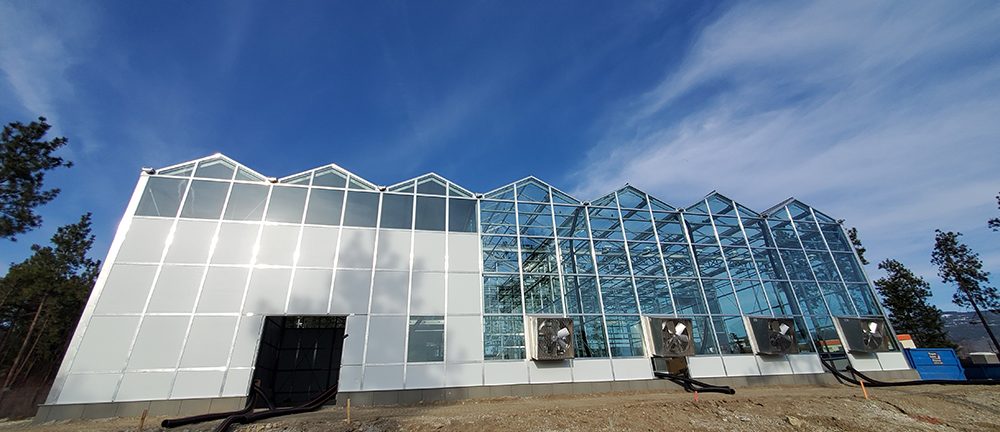
Research conducted at UBCO’s new Plant Growth Facility will have local and global impacts.
Scientific director Michael Deyholos shares why the state-of-the art facility is significant for UBCO.
 Q: What is your vision as scientific director of the new Plant Growth Facility?
Q: What is your vision as scientific director of the new Plant Growth Facility?
MD: This is an exciting opportunity to oversee the implementation of a state-of-the-art new research facility. It’s an opportunity to support the incredible work being done by faculty, and engage other researchers in the interior, including government and industrial commercial researchers, to demonstrate UBCO’s commitment to agriculture and plant research.
Q: What are some of the features of this state-of-the-art new research space?
MD: It’s a 5,100 square-foot space and has capacity for more than 10,000 individual plants. Sustainability and energy conservation were a priority in the design, including the use of double-paned glass not typically seen in greenhouses. Evaporative cooling, reflective flooring, shade cloths, and computerized ventilation have replaced traditional air conditioning, making the space extremely energy efficient. The growth space is divided in six zones to allow for both tropical and temperate (local) plants to be grown, and to isolate plants that are being tested for pest and disease resistance.
Q: Why is this research facility needed?
MD: There are many professors at UBCO who lead very productive research teams and are in need of greenhouse space. The projects run the gamut of pure and applied research, including adaptation to climate change, interactions with beneficial and pathogenic microbes, effects of wildfires on native and cultivated crops, and obtaining useful new chemicals from plants. The Plant Growth Facility is essential for research in these areas to continue on their current trajectory.
Q: How will this facility impact agricultural research?
MD: We’re doing world-class agricultural research at UBCO and the outcomes will benefit the Okanagan, as well as national and global sectors. For example, we’re studying a particular disease that affects flax grown in the prairies and also affects bananas grown in tropical climates. The research areas that will be explored in the Plant Growth Facility will address Canada’s top climate change risks and support Canada’s economic sector strategy in agriculture and agri-food manufacturing to achieve growth, food security and sustainability.
Q: Are there any specific research projects you can highlight?
MD: There’s so much going on that it’s difficult to highlight just a few. Some researchers are trying to address Okanagan specific problems, whether it’s with native plants, apple or cherry orchards, or grapes. Others are working on international issues.
What Miranda Hart and her team are doing is exciting – to find more sustainable ways to grow plants by looking at their natural partnerships with fungus in the soil. This has much potential for reducing fertilizers and pesticides, and reducing water usage.
Susan Murch has worked for many years with the non-profit organization PlantSMART to increase food security and distribute breadfruit plants around the world. She is finding all kinds of interesting ways to make useful products, including gluten-free bread and natural mosquito repellants.
Several of UBCO’s Eminence Clusters of Research Excellence are doing some great interdisciplinary work involving agriculture. The Agricultural Technologies & Bioproducts team, led by Soheil Mahmoud is studying a variety of plants to develop new sources of natural health products and food ingredients. The Biocomposites cluster, led by Abbas Milani, is growing natural fiber crops, including flax, to isolate fibers that can replace fiberglass in composite construction materials like car body panels. The Wine & Grapes cluster led by Wes Zandberg is focused on helping grapevines resist disease and use less water.
Q: What research projects are you personally looking forward to?
MD: Researching phytocannabinoids in rhododendrons. It started as a curiosity of mine, something with potential applications that has developed into an exciting project. I have an outstanding student who has already demonstrated the presence of these compounds in a type of rhododendron that hasn’t been detected before. She’ll be looking at how hormones, and the way we grow the plants, affect the production of these chemicals.
Phytocannabinoids found in plants have the same benefits as cannabinoids found in cannabis. I’m not aware of other researchers in Canada who are taking this kind of approach. I’ll be continuing my research of flax in connection to a number of different projects, both in the natural fibres and healthful components of the seed and oil, and also using flax as a model of disease resistance.
Q: What research possibilities do you envision for the future?
MD: The building is designed to expand and additional glass rooms can be added on to the main structure without having to build more core supports. Demand for greenhouse space, both on and off campus, is so great we anticipate a future need for additional space. Ultimately, we’d really like to have some measurable impact on the regional economy. I believe we have a leading group of academic researchers that could establish a national centre in plant biochemistry.